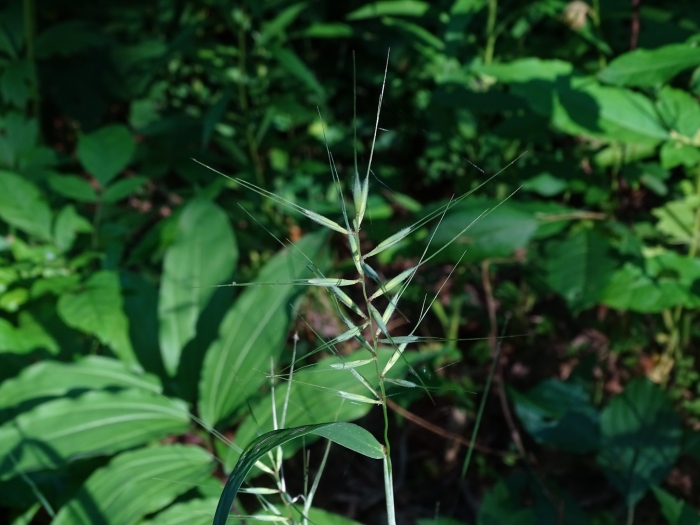Bottlebrush Grass
(Elymus hystrix)
Bottlebrush Grass (Elymus hystrix)
/
/

Reuven Martin
Public Domain
Image By:
Reuven Martin
Recorded By:
Copyright:
Public Domain
Copyright Notice:
Photo by: Reuven Martin | License Type: Public Domain | License URL: http://creativecommons.org/publicdomain/zero/1.0/ | Rights Holder: Reuven Martin | Publisher: iNaturalist | Date Created: 2018-06-30T08:15:02-07:00 |

















































Estimated Native Range
Summary
Elymus hystrix, commonly known as Bottlebrush Grass, is a semi-deciduous perennial grass native to a variety of habitats including open woodlands, forest edges, and grasslands in Central and Eastern USA. It typically grows to a height of 2-3 feet (0.6-0.9 meters) and a width of 1-2 feet (0.3-0.6 meters). The plant features a distinctive inflorescence that resembles a bottlebrush, hence its common name, with bristly, elongated spikelets that appear in mid to late summer. The flowers are not particularly showy but add a unique texture to the landscape. Bottlebrush Grass is valued for its adaptability to various soil conditions and its ability to thrive in both full sun and part shade.
Bottlebrush Grass is often used in naturalized areas, meadow gardens, and as a border plant due to its upright form and interesting seed heads. It is a low-maintenance option that requires minimal watering once established and can grow in a range of soil types, though it prefers well-drained soils. It is not known for having serious disease or pest issues, but it can self-seed prolifically, which may be undesirable in some garden settings. This grass is also beneficial for erosion control and provides habitat and food for wildlife.CC BY-SA 4.0
Bottlebrush Grass is often used in naturalized areas, meadow gardens, and as a border plant due to its upright form and interesting seed heads. It is a low-maintenance option that requires minimal watering once established and can grow in a range of soil types, though it prefers well-drained soils. It is not known for having serious disease or pest issues, but it can self-seed prolifically, which may be undesirable in some garden settings. This grass is also beneficial for erosion control and provides habitat and food for wildlife.CC BY-SA 4.0
Plant Description
- Plant Type: Grass
- Height: 2-3 feet
- Width: 1-2 feet
- Growth Rate: Moderate
- Flower Color: N/A
- Flowering Season: Summer
- Leaf Retention: Deciduous
Growth Requirements
- Sun: Full Sun, Part Shade
- Water: Low, Medium
- Drainage: Slow, Medium, Fast
Common Uses
Bird Garden, Butterfly Garden, Deer Resistant, Drought Tolerant, Erosion Control, Low Maintenance, Street Planting
Natural Habitat
Native to open woodlands, forest edges, and grasslands in Central and Eastern USA
Other Names
Common Names: Eastern Bottlebrush Grass, Bottle-Brush-Grass, Glumeless Wildrye, Gymnostique Hérisson, Hystrix Étalé, Élyme Étalé, Eastern Bottle-Brush Grass
Scientific Names: , Elymus hystrix, Hystrix patula, Elymus hystrix var. bigelovianus, Elymus hystrix f. bigelovianus, Asprella hystrix, Hystrix hystrix, Hystrix patula var. bigeloviana, Asperella hystrix, Gymnostichum hystrix
GBIF Accepted Name: Elymus hystrix L.